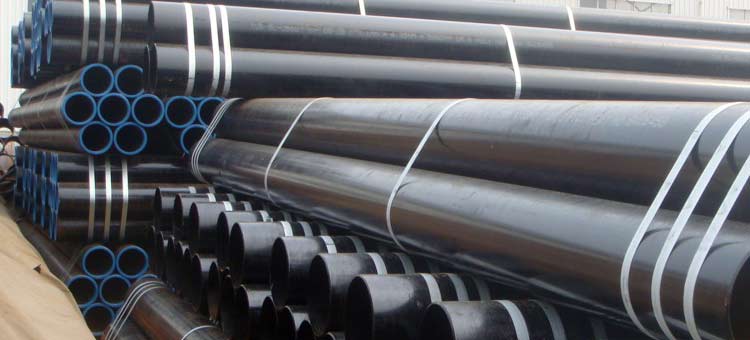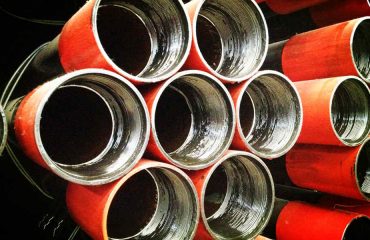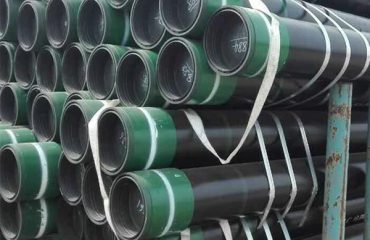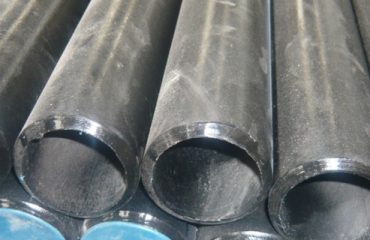
Hàn điện ASTM A672 (EFW) Ống Thép
Giới thiệu
ASTM A672 là một thông số kỹ thuật bao gồm hàn điện tổng hợp (EFW) ống thép được thiết kế cho dịch vụ áp suất cao ở nhiệt độ vừa phải. Những ống này thường được sử dụng trong các ngành công nghiệp như sản xuất điện, hóa, dầu và khí đốt, và truyền nước. Thông số kỹ thuật cung cấp hướng dẫn cho việc sản xuất, thử nghiệm, và kiểm tra các ống thép để đảm bảo chúng đáp ứng các yêu cầu về tính chất cơ học và hiệu suất cần thiết cho các ứng dụng áp suất cao.
Quy trình EFW là phương pháp hàn sử dụng hồ quang điện để kết hợp các tấm thép lại với nhau, tạo thành đường nối dọc. Quá trình này có hiệu quả cao và tạo ra các ống có tính toàn vẹn về cấu trúc và độ bền cơ học tuyệt vời. Ống ASTM A672 có nhiều loại khác nhau dựa trên loại thép được sử dụng và các tính chất cơ học cần thiết.
Bài viết này sẽ tìm hiểu quy trình sản xuất, Tính chất cơ học, và ứng dụng của ống thép ASTM A672 EFW, cũng như các phương pháp thử nghiệm được sử dụng để đảm bảo chúng phẩm chất và hiệu suất.
Mục lục
- Ống thép ASTM A672 EFW là gì?
- Quy trình sản xuất ống thép ASTM A672 EFW
- Hàn nhiệt hạch điện (EFW) Quá trình
- nhiệt khí
- Các loại và hạng của ống thép ASTM A672
- Tính chất cơ học của ống thép ASTM A672 EFW
- Yêu cầu kiểm tra và kiểm tra
- chắc chắn kiểm tra (NDT)
- Kiểm tra thủy tĩnh
- Ứng dụng của ống thép ASTM A672 EFW
- Các câu hỏi thường gặp (Câu hỏi thường gặp)
- Sự kết luận
Ống thép ASTM A672 EFW là gì? {#ống-thép-astm-a672-efw-thép là gì}
ASTM A672 là thông số kỹ thuật tiêu chuẩn cho hàn điện tổng hợp (EFW) ống thép được thiết kế cho dịch vụ áp suất cao ở nhiệt độ vừa phải. Những ống này được chế tạo từ bình áp lực phẩm chất tấm thép được hàn bằng hồ quang điện. Thông số kỹ thuật bao gồm các đường ống có đường nối dọc và được thiết kế để sử dụng trong các ứng dụng đòi hỏi độ bền và độ bền cao.
Các tính năng chính của ống thép ASTM A672 EFW:
-
hàn điện tổng hợp (EFW): Các đường ống được sản xuất bằng quy trình EFW, liên quan đến việc kết hợp các tấm thép lại với nhau bằng hồ quang điện. Quá trình này tạo ra mối hàn dọc chắc chắn, có thể chịu được áp lực cao.
-
Áp Lực Tàu phẩm chất Thép: Các tấm thép dùng trong sản xuất ống ASTM A672 là loại thép chịu áp lực, nghĩa là chúng được thiết kế để chịu được áp suất bên trong cao mà không bị hỏng hóc.
-
Dịch vụ cao áp: Ống ASTM A672 phù hợp cho các ứng dụng áp suất cao, chẳng hạn như nồi hơi, bộ trao đổi nhiệt, và đường ống trong ngành dầu khí.
-
Ứng dụng nhiệt độ vừa phải: Thông số kỹ thuật bao gồm các đường ống được thiết kế để sử dụng ở nhiệt độ vừa phải, thường lên tới 400°C (752° F).
-
Các lớp khác nhau: Ống ASTM A672 có sẵn ở các loại khác nhau dựa trên loại thép được sử dụng và các tính chất cơ học cần thiết. Các cấp được xác định bởi thành phần hóa học và xử lý nhiệt của thép.
Quy trình sản xuất ống thép ASTM A672 EFW {#sản xuất-quy trình-của-astm-a672-efw-thép-ống}
Việc sản xuất ống thép ASTM A672 EFW bao gồm một số bước, bao gồm cả việc lựa chọn các tấm thép chất lượng bình chịu áp lực, hàn nhiệt hạch điện (EFW) Quá trình, và xử lý nhiệt để đạt được các tính chất cơ học mong muốn.
Hàn nhiệt hạch điện (EFW) Quá trình {#quy trình hàn điện-nhiệt-efw-}
Quá trình EFW là một loại hàn hồ quang sử dụng hồ quang điện để kết hợp các tấm thép lại với nhau dọc theo một đường nối dọc. Quá trình này bao gồm các bước sau:
-
Chuẩn bị đĩa: Các tấm thép đầu tiên được cắt theo kích thước yêu cầu và được kiểm tra xem có bất kỳ khuyết tật hoặc khiếm khuyết bề mặt nào không..
-
Chuẩn bị cạnh: Các cạnh của tấm thép được vát để đảm bảo sự kết dính thích hợp trong quá trình hàn. Góc vát được kiểm soát cẩn thận để đạt được mối hàn chắc chắn.
-
Hàn nhiệt hạch điện: Các tấm được đặt cạnh nhau, và một hồ quang điện được sử dụng để làm nóng chảy các cạnh của tấm, tạo ra một bể hàn. Khi vòng cung di chuyển dọc theo đường may, kim loại nóng chảy đông cứng lại, tạo thành một mối hàn liên tục dọc theo chiều dài của ống.
-
Kiểm tra mối hàn: Mối hàn được kiểm tra các khuyết tật như độ xốp, vết nứt, hoặc sự kết hợp không hoàn toàn. Kiểm tra không phá hủy (NDT) phương pháp, chẳng hạn như kiểm tra siêu âm hoặc kiểm tra chụp ảnh phóng xạ, thường được sử dụng để đảm bảo chất lượng mối hàn.
-
Định cỡ và định hình: Sau khi hàn, ống được đưa qua một loạt con lăn để đạt được đường kính và độ tròn mong muốn. Ống cũng được kiểm tra độ chính xác về kích thước.
nhiệt khí {#xử lý nhiệt}
Sau quá trình EFW, các đường ống có thể được xử lý nhiệt để cải thiện tính chất cơ học của chúng và giảm bớt ứng suất dư gây ra trong quá trình hàn. Loại xử lý nhiệt phụ thuộc vào loại thép và yêu cầu ứng dụng. Các quy trình xử lý nhiệt phổ biến bao gồm:
-
Bình thường hóa: Ống được nung nóng đến nhiệt độ trên điểm tới hạn của nó và sau đó được làm mát trong không khí. Quá trình này tinh chỉnh cấu trúc hạt và cải thiện độ dẻo dai của thép.
-
Làm nguội và ủ: Ống được nung nóng đến nhiệt độ cao và sau đó làm nguội nhanh (dập tắt) trong nước hoặc dầu. Sau đó nó được hâm nóng lại ở nhiệt độ thấp hơn (tôi luyện) để cải thiện độ dẻo và độ dẻo dai của nó.
-
Giảm căng thẳng: Ống được làm nóng đến nhiệt độ vừa phải và sau đó được làm nguội từ từ để giảm ứng suất dư mà không làm thay đổi đáng kể tính chất cơ học.
Các loại và hạng của ống thép ASTM A672 {#cấp-và-loại-của-astm-a672-thép-ống}
Ống thép ASTM A672 có sẵn ở nhiều loại và hạng khác nhau dựa trên loại thép được sử dụng và các tính chất cơ học cần thiết. Các cấp được xác định bởi thành phần hóa học của thép, trong khi các lớp học dựa trên các yêu cầu thử nghiệm và xử lý nhiệt.
Các lớp phổ biến:
-
Lớp B60: Loại này được làm từ thép carbon có độ bền kéo tối thiểu là 415 MPa (60,000 psi). Nó thường được sử dụng cho các ứng dụng áp suất vừa phải.
-
Lớp C65: Loại này được làm từ thép cacbon-mangan có độ bền kéo tối thiểu là 450 MPa (65,000 psi). Nó phù hợp cho các ứng dụng áp suất cao hơn.
-
Lớp C70: Loại này được làm từ thép cacbon-mangan có độ bền kéo tối thiểu là 485 MPa (70,000 psi). Nó được sử dụng trong các ứng dụng áp suất cao, nơi sức mạnh và độ bền là rất quan trọng.
Lớp học:
- Lớp học 10: Các ống thuộc loại này được cung cấp ở trạng thái hàn mà không cần xử lý nhiệt.
- Lớp học 12: Ống thuộc loại này được xử lý nhiệt sau khi hàn để cải thiện tính chất cơ học và giảm ứng suất dư.
- Lớp học 22: Các ống thuộc loại này trải qua quá trình làm nguội và tôi luyện để đạt được độ bền và độ dẻo dai cao hơn.
Đặc điểm kỹ thuật vật liệu {#đặc điểm kỹ thuật vật liệu}
ASTM A672 ống được làm từ tấm thép chất lượng bình chịu áp lực được hàn bằng cách sử dụng Hàn nhiệt hạch điện (EFW) Quá trình. Đặc điểm kỹ thuật bao gồm các đường ống ở nhiều dạng khác nhau Lớp và Lớp học, được xác định bởi Thành phần hóa học của thép và nhiệt khí áp dụng sau khi hàn.
Các tính năng chính của ống thép ASTM A672 EFW:
- hàn điện tổng hợp (EFW): Ống được hàn bằng cách sử dụng hồ quang điện để nung chảy các tấm thép, tạo ra một mối hàn dọc.
- Thép chất lượng bình chịu áp lực: Các tấm thép được sử dụng là chất lượng bình áp lực, đảm bảo đường ống có thể chịu được áp lực nội bộ cao.
- Dịch vụ cao áp: Ống ASTM A672 được thiết kế cho ứng dụng áp suất cao tại nhiệt độ vừa phải.
- Lớp và lớp: Đặc điểm kỹ thuật cung cấp nhiều Lớp và Lớp học dựa trên Thành phần hóa học và nhiệt khí của thép.
Bảng thành phần hóa học {#bảng thành phần hóa học}
Thành phần hóa học của ống thép ASTM A672 thay đổi tùy theo Lớp của thép được sử dụng. Bảng dưới đây phác thảo thành phần hóa học điển hình cho các loại phổ biến được sử dụng trong ống ASTM A672.
| TỐ | Lớp B60 (%) | Lớp C65 (%) | Lớp C70 (%) |
|---|---|---|---|
| Carbon (C) | 0.26 tối đa | 0.24 tối đa | 0.23 tối đa |
| mangan (MN) | 0.98 tối đa | 1.20 tối đa | 1.35 tối đa |
| phốt pho (P) | 0.035 tối đa | 0.035 tối đa | 0.035 tối đa |
| lưu huỳnh (S) | 0.035 tối đa | 0.035 tối đa | 0.035 tối đa |
| silicon (Si) | 0.13-0.45 | 0.13-0.45 | 0.13-0.45 |
| crom (CR) | 0.30 tối đa | 0.30 tối đa | 0.30 tối đa |
| kền (Ni) | 0.30 tối đa | 0.30 tối đa | 0.30 tối đa |
| molypden (Mo) | 0.12 tối đa | 0.12 tối đa | 0.12 tối đa |
| Đồng (Cu) | 0.40 tối đa | 0.40 tối đa | 0.40 tối đa |
| chất hóa học (V) | 0.08 tối đa | 0.08 tối đa | 0.08 tối đa |
Ghi chú:
- Hàm lượng cacbon là yếu tố then chốt quyết định sự sức mạnh và Cứng của thép. Cải thiện hàm lượng carbon thấp hơn khả năng hàn và độ dẻo.
- mangan cải thiện Độ bền kéo và độ cứng của thép.
- phốt pho và lưu huỳnh được giữ ở mức thấp để ngăn ngừa độ giòn và cải thiện độ dẻo dai.
- silicon hoạt động như một chất khử oxy trong quá trình sản xuất thép và cải thiện sức mạnh.
Bảng tính chất cơ học {#bảng tính chất cơ học}
Các tính chất cơ học của ống thép ASTM A672 được xác định bởi Lớp và Lớp học của đường ống, cũng như nhiệt khí áp dụng sau khi hàn. Bảng dưới đây cung cấp các đặc tính cơ học điển hình cho các loại ống thông dụng của tiêu chuẩn ASTM A672.
| Tài sản | Lớp B60 | Lớp C65 | Lớp C70 |
|---|---|---|---|
| Độ bền kéo (MPa) | 415 Min (60,000 psi) | 450 Min (65,000 psi) | 485 Min (70,000 psi) |
| Mang lại sức mạnh (MPa) | 240 Min (35,000 psi) | 275 Min (40,000 psi) | 275 Min (40,000 psi) |
| Kéo dài (%) | 22 Min | 22 Min | 22 Min |
| Độ bền va đập (J) | Thay đổi theo lớp | Thay đổi theo lớp | Thay đổi theo lớp |
Ghi chú:
- Độ bền kéo là ứng suất lớn nhất mà vật liệu có thể chịu được trước khi đứt.
- Mang lại sức mạnh là ứng suất tại đó vật liệu bắt đầu biến dạng dẻo.
- Kéo dài là thước đo độ dẻo của vật liệu, cho biết nó có thể giãn ra bao nhiêu trước khi đứt.
- Độ bền va đập thường được đo bằng cách sử dụng Thử nghiệm rãnh chữ V Charpy, đặc biệt là cho các ứng dụng trong môi trường nhiệt độ thấp.
Yêu cầu kiểm tra và kiểm tra {#yêu cầu kiểm tra và kiểm tra}
Để đảm bảo chất lượng và hiệu suất của ống thép ASTM A672 EFW, một số phương pháp thử nghiệm và kiểm tra được sử dụng trong quá trình sản xuất. Các thử nghiệm này giúp xác định bất kỳ khiếm khuyết hoặc sự không nhất quán nào trong vật liệu hoặc mối hàn có thể làm ảnh hưởng đến tính chất cơ học hoặc tính toàn vẹn cấu trúc của đường ống..
chắc chắn kiểm tra (NDT) {#thử nghiệm không phá hủy-ndt}
chắc chắn kiểm tra (NDT) các phương pháp được sử dụng để kiểm tra các khuyết tật ở đường hàn và thân ống mà không làm hỏng vật liệu. Các phương pháp NDT phổ biến bao gồm:
-
Kiểm tra siêu âm (OUT): Sóng siêu âm được sử dụng để phát hiện các khuyết tật bên trong như vết nứt, khoảng trống, hoặc sự kết dính không hoàn toàn trong mối hàn hoặc thân ống.
-
Kiểm tra chụp X quang (RT): Tia X hoặc tia gamma được sử dụng để tạo ra hình ảnh của mối hàn, cho phép người kiểm tra xác định các khuyết tật bên trong như độ xốp, tạp chất xỉ, hoặc vết nứt.
-
Kiểm tra hạt từ tính (MT): Phương pháp này dùng để phát hiện các khuyết tật bề mặt của vật liệu sắt từ. Một từ trường được đặt vào đường ống, và các hạt sắt được sử dụng để làm lộ ra bất kỳ vết nứt hoặc sự gián đoạn nào trên bề mặt.
-
nhuộm thử nghiệm thẩm thấu (PT): Thuốc nhuộm được bôi lên bề mặt ống, và bất kỳ vết nứt hoặc khuyết tật nào sẽ hấp thụ thuốc nhuộm, làm cho chúng có thể nhìn thấy được dưới ánh sáng cực tím.
Kiểm tra thủy tĩnh {#thử thủy tĩnh}
Thử nghiệm thủy tĩnh là một thử nghiệm quan trọng được sử dụng để đảm bảo rằng đường ống có thể chịu được áp suất bên trong mà nó sẽ phải chịu khi sử dụng.. Trong quá trình kiểm tra này, đường ống chứa đầy nước và được điều áp đến mức cao hơn áp suất vận hành của nó. Sau đó, đường ống được kiểm tra xem có rò rỉ hoặc biến dạng nào có thể cho thấy điểm yếu trong vật liệu hoặc mối hàn không..
- áp lực kiểm tra: Áp suất thử nghiệm thường là 1.5 lần áp suất thiết kế của đường ống.
- Khoảng thời gian: Ống được giữ ở áp suất thử trong một khoảng thời gian xác định (thường xuyên 5 để 15 phút) để đảm bảo nó có thể duy trì áp suất mà không bị hỏng.
Ứng dụng của ống thép ASTM A672 EFW {#ứng dụng của astm-a672-efw-ống thép}
Ống thép ASTM A672 EFW được sử dụng trong nhiều ngành công nghiệp và ứng dụng trong đó dịch vụ áp suất cao và tính toàn vẹn của cấu trúc là rất quan trọng. Một số ứng dụng phổ biến bao gồm::
-
Sản xuất điện: Ống ASTM A672 được sử dụng trong nồi hơi, bộ trao đổi nhiệt, và đường ống dẫn hơi nước trong các nhà máy điện nhờ khả năng chịu được áp suất cao và nhiệt độ vừa phải.
-
Ngành công nghiệp hóa dầu: Những ống này được sử dụng trong các nhà máy lọc dầu, nhà máy hóa chất, và các cơ sở hóa dầu để vận chuyển chất lỏng và khí ăn mòn dưới áp suất cao.
-
Ngành công nghiệp dầu mỏ và khí đốt: Ống ASTM A672 được sử dụng trong đường ống dẫn dầu khí, Nền tảng ngoài khơi, và đường ống ngầm để vận chuyển dầu thô, khi tự nhiên, và các hydrocacbon khác.
-
Truyền nước: Những ống này được sử dụng trong các hệ thống truyền dẫn nước để vận chuyển nước uống được, nước thải, và nước công nghiệp dưới áp suất cao.
-
Ứng dụng kết cấu: Ống ASTM A672 được sử dụng trong các ứng dụng kết cấu như cột, dầm, và hỗ trợ trong các tòa nhà và công trình công nghiệp nơi cần có sức mạnh và độ bền.
Các câu hỏi thường gặp (Câu hỏi thường gặp) {#Câu hỏi thường gặp}
1. Sự khác biệt giữa ống EFW và ERW là gì?
EFW (hàn điện tổng hợp) Các ống được hàn bằng hồ quang điện để nối các tấm thép lại với nhau, trong khi bom mìn (Điện kháng hàn) các ống được hàn bằng điện trở để làm nóng các cạnh của thép và nối chúng lại với nhau. Ống EFW thường được sử dụng cho các ứng dụng áp suất cao, trong khi ống ERW được sử dụng cho các ứng dụng áp suất thấp đến trung bình.
2. Các loại phổ biến của ống ASTM A672 là gì?
Các loại ống phổ biến của tiêu chuẩn ASTM A672 bao gồm Loại B60, Lớp C65, và lớp C70, dựa trên thành phần hóa học và tính chất cơ học của thép.
3. Nhiệt độ hoạt động tối đa cho ống ASTM A672 là bao nhiêu?
Ống ASTM A672 được thiết kế để sử dụng ở nhiệt độ vừa phải, thường lên tới 400°C (752° F), tùy thuộc vào cấp và loại của đường ống.
4. Chất lượng của ống ASTM A672 được đảm bảo như thế nào?
Chất lượng ống ASTM A672 được đảm bảo thông qua thử nghiệm không phá hủy (NDT) Các phương pháp như kiểm tra siêu âm, Kiểm tra chụp X quang, và thử nghiệm hạt từ tính, cũng như thử nghiệm thủy tĩnh để xác minh khả năng chịu được áp suất bên trong của đường ống.
5. Những ngành nào sử dụng ống thép ASTM A672 EFW?
Ống thép ASTM A672 EFW được sử dụng trong các ngành công nghiệp như sản xuất điện, hóa, dầu và khí đốt, và truyền nước do khả năng chịu được áp suất cao và nhiệt độ vừa phải.
Sự kết luận {#Sự kết luận}
Ống thép ASTM A672 EFW được thiết kế cho dịch vụ áp suất cao ở nhiệt độ vừa phải, khiến chúng trở nên lý tưởng để sử dụng trong các ngành công nghiệp như sản xuất điện, hóa, dầu và khí đốt, và truyền nước. hàn nhiệt hạch điện (EFW) Quá trình đảm bảo mối hàn dọc chắc chắn có thể chịu được áp lực bên trong cao, trong khi việc sử dụng thép chất lượng bình chịu áp lực đảm bảo các đường ống có các đặc tính cơ học cần thiết cho các ứng dụng đòi hỏi khắt khe.
Các yêu cầu thử nghiệm và kiểm tra được nêu trong tiêu chuẩn ASTM A672, bao gồm thử nghiệm không phá hủy và thử nghiệm thủy tĩnh, giúp đảm bảo chất lượng và hiệu suất của đường ống, làm cho chúng trở thành sự lựa chọn đáng tin cậy cho các ứng dụng kết cấu và áp suất cao.




bạn phải đăng nhập để viết bình luận.